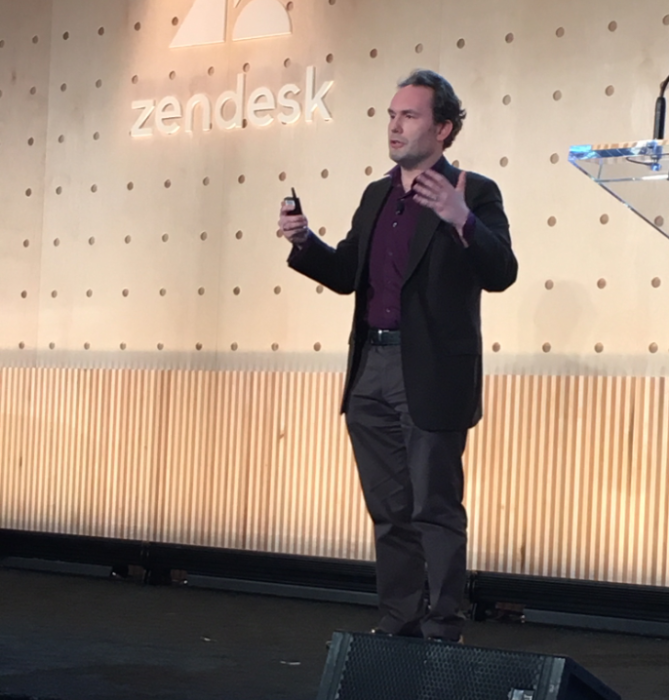Two main themes emerged for me at the Zendesk Showcase in New York yesterday. First, the customer service and support platform is doubling down on conversational engagement. Second, and perhaps more significant in the long-run, it’s directing attention to its own, open and flexible CRM, Sunshine.
Let the sun shine
That’s right, CRM. Not content with being a leading vendor in cross-channel support and service, as part of overall CX, Zendesk is not shying away from a more holistic approach to experience management, not only with Sunshine, but also with Sell, formerly known as Base, sales automation software for sales teams. CRM and sales automation; a familiar combination. And who should be on-stage at Showcase, but veteran Salesforce product leader Shawna Wolverton (now SVP of product at Zendesk), and former Salesforce product marketer Lisa Kant (now VP of product marketing at Zendesk)?
I’m just pointing out which way the wind appears to be blowing.
Of course, dealing now with some 800 million unique requests (five times the 2014 figure), two billion tickets, and a rocketing increase in self-service requests (13 times 2014), Zendesk is gushes information about where the customer is, what she is doing, and how to make her happy, all gold-dust for sales teams — if promptly fed back into a sales dashboard and made available and actionable.
But why is Zendesk in the business of offering that system of record for sales, especially when it already integrates, for example, with Salesforce and Microsoft Dynamics 365? According to President of product Adrian McDermott, the open and flexible Sunshine CRM helps brands avoid two traps. One is creating their own proprietary system, with an almost guaranteed future of heavy technical debt (are brands still doing this?). The other is committing to one of the larger eco-systems on the market, with a long implementation cycle, which never quite catches up to the nimble needs of today’s business environment.
Sunshine, said McDermott, is “the best of both worlds.” Because it’s built on AWS, it’s not a closed garden: developers can customize it using familiar code and standards. But it’s also as scaleable as any brand could wish.
This is a bold play when Salesforce and Adobe, in particular, are placing a strong emphasis on the openness of their platforms, and offering a compendious selection of third party apps designed to integrate with them. I asked Luke Behnke, VP product at Zendesk, to explain the differentiation to me.
“Legacy, first-generation CRM platforms have certainly started to talk much more about openness of their technology and their ecosystem. The reality is that transitioning away from 20 years of being a proprietary cloud platform built on a custom coding language and development environment is incredibly difficult to actually do. In general, we see these announcements as validation of the open, cloud-based strategy we have had since the beginning.”
Developers are already familiar with AWS cloud technology, and its open APIs and libraries, said Behnke. “Zendesk Sunshine will help brands connect their customer data and then build great customer and employee experiences on top of that data. In addition,” he added, “Sunshine is event-based and real-time, versus focusing on a static database record of the customer.”
As for the roadmap, Zendesk wants to make it easier to get data in and out of Sunshine, enhance security compliance at scale, and provide an ever-better developer experience.
Smooch like that
Closer to home for Zendesk’s traditional business is a re-affirmed commitment to conversational channels, signaled by the announcement yesterday that it has acquired established Zendesk partner Smooch. Although Smooch is an omnichannel messaging solution, it has particular strength in text messaging (it was a pioneer partner with WhatsApp for business). This matters to Zendesk customer like Colin Corwley, VP of customer experience at healthy meals delivery service Freshly.
“Omnichannel,” said Crowley, “is about trusting the customer more than you trust yourself.” Brands once based choice of channel for support and service (and other) communications on their own convenience, on what they were best prepared to staff. Crowley says brands need to step down: “The customer is the best judge of the most efficient and effective way to contact a business. You need to be there, on their schedule.”
Increasingly, customers use social messaging: 72 trillion messages sent in 2018, 1.5 billion people on WhatsApp, Behnke told me. It’s valued for its speed and intimacy — when brands are equipped to manage it anyway. Obviously, the omnichannel element means being able to re-identify the customer, and respond in a seamless way, whether they’re contacted by phone, email, or text.
Smooch supports these objectives, but why acquire it rather than just continue the partnership? Benhke said: “For years we’ve relied on Smooch to power various social channel integrations into Zendesk, and as messaging platforms rise in popularity, it is important to Zendesk, and ultimately our customers, that we help businesses deliver an incredible social and native messaging experience with their customers. We think integrating in Smooch’s incredible technology and their messaging-focused DNA into all that we do will help take this customer experience to the next level.”
On the roadmap is adding more social channels as part of the Zendesk Suite, and also, said Behnke, “helping companies deliver rich messaging experiences through the combined Zendesk-Smooch web and mobile “embeddables”, allowing any customer to embed a messaging experience right within their products.”








